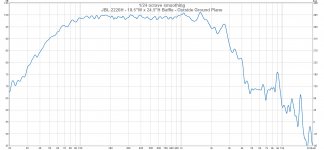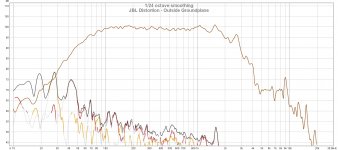Hi, gentlemen, I wanted to ask which speaker would be best for cutting 800-900Hz
Altec 416, JBL2226H, AE TD15M, ..? for cooperation with Radian 950PB
Altec 416, JBL2226H, AE TD15M, ..? for cooperation with Radian 950PB
As an owner of a lot of 2225/6 and AE TD15 drivers, I'd say the 15M sealed above about 100Hz and the JBL of you need to port it and get it to say 40Hz.
Moderately hard to get and can be expensive, especially if not in the US or Canada.JBL 2216Nd
Not sure of cost or availability
Thanks for the link though, I'd not seen that.
The 2265h differential drive woofer can be ordered from Parts Express:
JBL 2265HPL 338343-003X 15" Neo Woofer
The 2216nd-1 (i.e, the little more HiFi-ish version of the 2216) can be had for USD 600 at Speaker Exchange. They also once had the 2216 but at the Moment it semm to be on request only.
Regards
Charles
JBL 2265HPL 338343-003X 15" Neo Woofer
The 2216nd-1 (i.e, the little more HiFi-ish version of the 2216) can be had for USD 600 at Speaker Exchange. They also once had the 2216 but at the Moment it semm to be on request only.
Regards
Charles
JBL 2226H Measurements
I know this is an old thread but ...... I had a pair of JBL 2226H sitting around collecting dust and so I thought about recycling them into another project.
I took quick measurements and was pretty happy to see the results. Nice smooth mid-range with minimal cone break up. This is raw response, 1/24th smoothing, no EQ, no baffle step circuitry, etc
This measurement was taken outside, groundplane method technique, with the mic placed 6.5 feet from the baffle (18"w x 24" tall - approximately the dimensions of Wanye 4pi Speakers), and the baffle tilted down so the woofer is facing the mic.
These measurements matched remarkably well to the measurements I took indoors utilizing the technique suggested by Mr. Bagby (RIP)- LINK.
Just thought I post my results here if anyone found themselves reading this thread.
I know this is an old thread but ...... I had a pair of JBL 2226H sitting around collecting dust and so I thought about recycling them into another project.
I took quick measurements and was pretty happy to see the results. Nice smooth mid-range with minimal cone break up. This is raw response, 1/24th smoothing, no EQ, no baffle step circuitry, etc
This measurement was taken outside, groundplane method technique, with the mic placed 6.5 feet from the baffle (18"w x 24" tall - approximately the dimensions of Wanye 4pi Speakers), and the baffle tilted down so the woofer is facing the mic.
These measurements matched remarkably well to the measurements I took indoors utilizing the technique suggested by Mr. Bagby (RIP)- LINK.
Just thought I post my results here if anyone found themselves reading this thread.
Attachments
The 2226 is a pretty special driver. Think about how old it is and it's still competitive. Really remarkable.
JBL 2226H Distortion
Here is the distortion chart from the same measurement.
How was the distortion window?
Here is the distortion chart from the same measurement.
Attachments
The 2226 is a pretty special driver. Think about how old it is and it's still competitive. Really remarkable.
I too was pleasantly surprised. I didn't include measurement of the second driver, but it was pretty bang-on (+/- 0.25 - 0.50db in the 80 - 2.8Khz, and thereafter start to divert as cone breakup creeps in).
sorry for resurrecting this... 🙂
You knowledgable people!
What is the usual life of a new 2226h (or similar jbl "pro" woofers)?
Like glue and foam I mean. Not through power abuse, lets say sitting in the box.
Thanks
You knowledgable people!
What is the usual life of a new 2226h (or similar jbl "pro" woofers)?
Like glue and foam I mean. Not through power abuse, lets say sitting in the box.
Thanks
I have a dozen or so, that after many years of hard work, have been sitting in boxes for >12y and are fine. Same with some even older 2225s. It's not like they have 70's era foam surrounds that rot.
aha! ok! Asking as recently a friends top line Infinity speakers from around '95?!? (cant remember) lost all foam...
Thanks
Thanks
Aha ok! I didnt know the difference.
By “treated well” you mean: a) no power abuse (Im in a home setting) b) some maintenance routine?
Thanks
By “treated well” you mean: a) no power abuse (Im in a home setting) b) some maintenance routine?
Thanks
b) some maintenance routine?
b) would be no exposure to extreme environmental conditions.
BTW: Your friend's Infinity speakers can be refoamed.
Regards
Charles
They spent thousands of hours in a PA at average levels that would make an audiophool weep. Keep the excursion and power within limits and don't get them wet. Or feed them after midnight.Aha ok! I didnt know the difference.
By “treated well” you mean: a) no power abuse (Im in a home setting) b) some maintenance routine?
Thanks
Excessive excursion or power can cause rapid, even instantaneous mechanical or thermal failure (a).a) no power abuse (Im in a home setting) b) some maintenance routine?
B) Every 20-30 years the driver may need to be rotated to reverse cone sag, which can eventually lead to the voice coil or former rubbing in the gap.
If the drivers have been stored horizontally for long periods of time, the suspension may settle forward or back from optimum position, that offset could cause more harmonic distortion than if the voice coil were properly centered.
Surround glue may dry out and crack and require re-freshening at similar intervals, depending on environmental conditions.
That said, many pleated surround drivers around for over 80 years are still working just fine, and have still not reached their "half life".
- Home
- Loudspeakers
- Multi-Way
- What makes the JBL 2226H such a popular driver?

